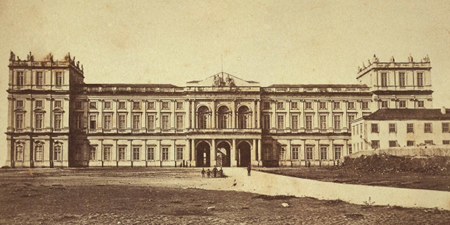
When Pope Alexander III officially recognized Afonso Henriques as king in 1179, Portugal joined other prestigious royal houses in Europe. Dynasties would come & go —with several tragedies in between— but royals ruled until the establishment of Portugal’s first republic in 1910. That span of 731 years gave Portugal much of its modern-day national heritage; however, unlike other European countries, royal palaces are not part of the main tourist circuit. Why not? Let’s examine some previous royal residences for an answer…
Coimbra’s brief stint as capital (1131-1255) required construction of a royal palace. But when the capital moved to Lisbon, the Coimbra palace transformed into the country’s first university. Adeus palácio. The initial royal residence in Lisbon had commanding views of city from the Castelo de São Jorge, but in 1511 King Manuel I wanted to be closer to the action on the waterfront. The magnificent palace he built would impress all visitors, royal or not, as they entered the city (pictured below, Wikipedia). Unfortunately, the 1755 earthquake-tsunami-fire took out the palace… one of the first buildings destroyed. The destruction disturbed King José I to such an extent that his new dwelling was nothing more than a series of wood & canvas tents built on the hills above the Mosteiro dos Jerónimos in Belém. Hardly luxurious, but no danger of being injured in another natural disaster! The original palace in the castle suffered damage during the earthquake as well, & royalty abandoned the notion of ever returning.
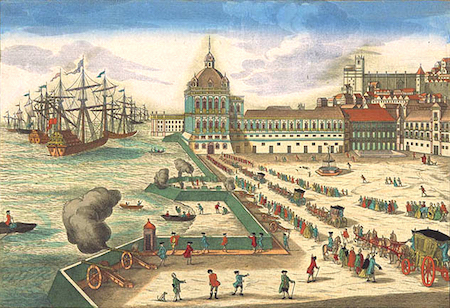

As Ajuda developed into a permanent royal residence without tents & was improved over decades, a fire in 1794 destroyed everything again. The crown decided in 1802 to build a grand, Neoclassical palace in the same spot, but Napoleon’s invasion & later national turmoils paused construction several times. Finally in the 1860s, enough of the original plan had been completed for the royal family to move in… even though they often rotated between the Palácio de Belém (now the Presidential residence) & the Palácio das Necessidades (today used as the Ministry of Foreign Affairs). The diagram below shows the large portion of the palace never built. Breathtaking scale.
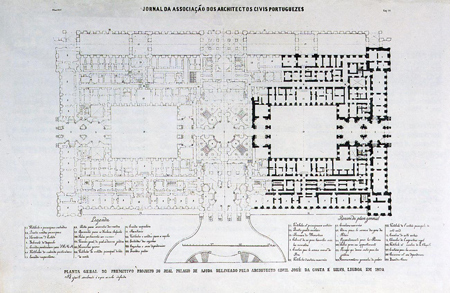
After proclamation of the republic in 1910, the Palácio da Ajuda became state property. Used for only a few official occasions over the years, the building usually sat closed like a tomb. The Estado Novo opened the palace to the public in 1968, & it continues to be used for important government ceremonies such as swearing in the Prime Minister.
Although a perfectly preserved yet incomplete 19th-century royal palace sits uphill from the mega-touristy Mosteiro dos Jerónimos, very few people visit Ajuda. I’m guilty of neglect as well. I spend lots of time every year in Lisboa, yet somehow never managed to see this until 2015. Perhaps lack of publicity? The uphill climb? Not sure, but Rafa & I enjoyed every minute of the visit… especially because we were the ONLY ones there.
A Baroque bell tower greets visitors from afar, the only bit of the original Royal Chapel left standing. A surrounding parking lot kills the ambiance, but what a palace! A statue of King Carlos I welcomes you to his home, entering via a domed foyer filled with allegorical statues. I went a little crazy taking pics of at least 17 —Providence, Loyalty, Diligence, Desire, Humanity, Constance, etc.— but my fave was Acção Virtuoza… a man clubbing a rather large serpent surely for the good of the people. Don’t miss the open patio with its unfinished western wall:
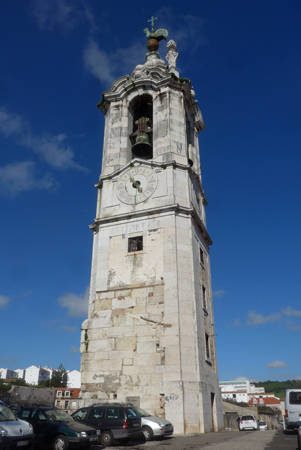
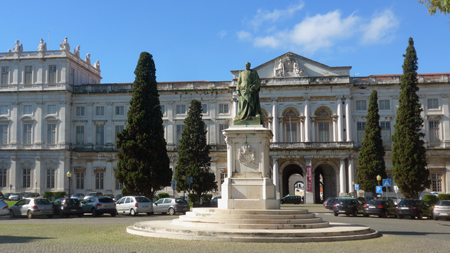

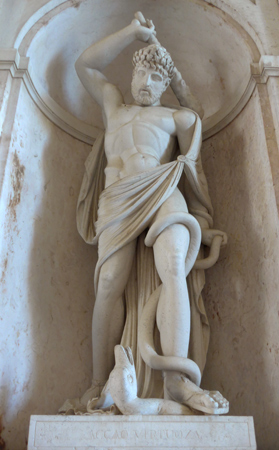
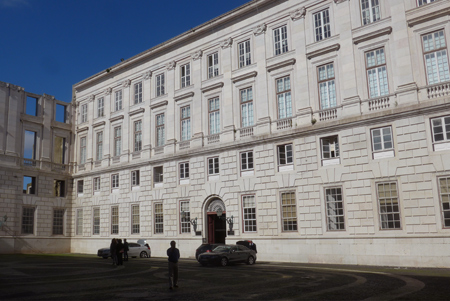
Photos were not allowed during our visit (I believe that has since changed), but since we were the only visitors to the palace & monitors were few & far between, we snuck quite a few pics. The informative website of the palace has good descriptions of each of the rooms. Shown below are the Sala das Tapeçarias Espanholas, the Jardim do Inverno & the Toucador da Rainha. Care & maintenance is commendable… imagining a family living here is easy. Given the social & economic problems of Portugal in the 20th century, I’m amazed that the palace is so well preserved.
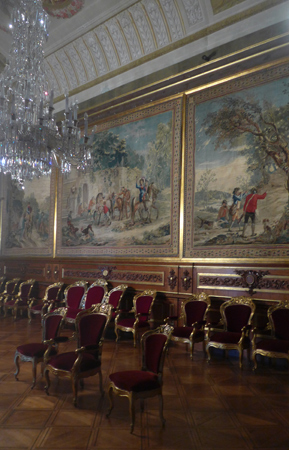
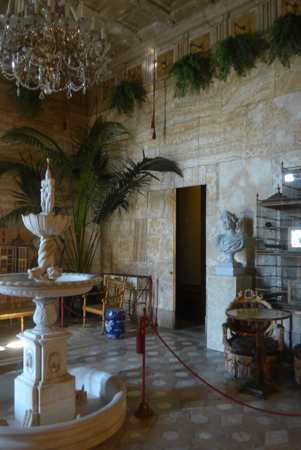

The throne room is naturally grand in scale, although the actual thrones are quite humble. One of my favorite places is the king’s painting studio with its NeoTudor, wooden interior just perfect for being creative. A painting of the Torre de Belém by Carlos I impressed me… I remember seeing the king’s sketches in the Sintra palace & thinking he was very talented.
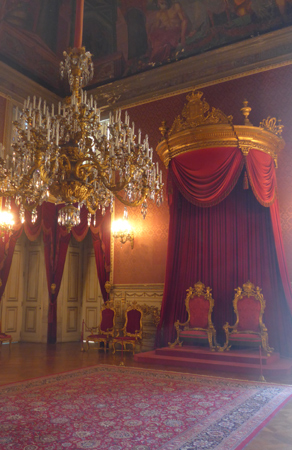
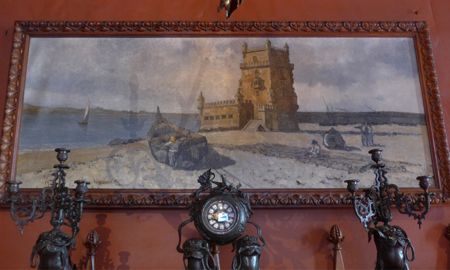
Finally, two magnificent dining rooms made me linger. The larger one wows due to its size, scale & magnificent ceiling fresco, but the smaller family dining room captured my interest as well. Later I found out that the silver centerpiece has an interesting story: Queen Maria Pia (1847-1911) gave the stunning piece to a bank as collateral on a loan. After exiling the monarchy, someone from the government found the centerpiece, realized what it was & purchased it to place back in the Palácio da Ajuda. Thanks to Paula Moura Pinheiro on the RTP show Visita Guiada for revealing that bit of history!
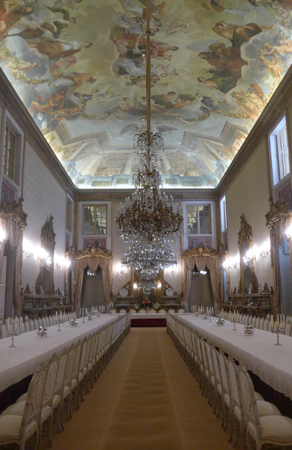
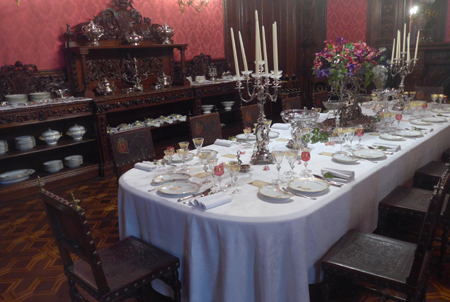
Although we had the palace to ourselves, crowds will come soon… Prime Minister António Costa announced a 15 million euro project to complete the palace by the end of 2018. Not the whole thing of course —I wish!— but they will add more rooms to the open, western façade & create a permanent space to display some of the 900 remaining crown jewels. Funds will come from the city government, the Lisbon tourist tax & 4 million euros from Holland’s reparation to Portugal after six pieces were stolen in a 2002 royal jewelry exhibit at The Hague Museum. I’ll hate to see the peacefulness of the palace disappear, but I can’t wait to see those scepters & crowns!
Travel tip: Start your morning at the palace, stroll down to the botanical garden, continue down to see the Igreja da Memória & leave the Mosteiro dos Jerónimos for the afternoon. Less crowds + beautiful sunsets from the riverfront & all downhill!
Update (17 Aug 2022): Took a bit longer than planned, but they’ve finished the museum & completed the end wall of the palace. I was lucky enough to be updating the Portugal guidebook for Rick Steves in June 2022, only a few weeks after the museum opened.

I understand the high security, but the museum entrance is poorly designed. A one-way hall with the history of official coinage is the only way in… but when people stop to read infopanels, they create a traffic jam. Get me to the jewels!
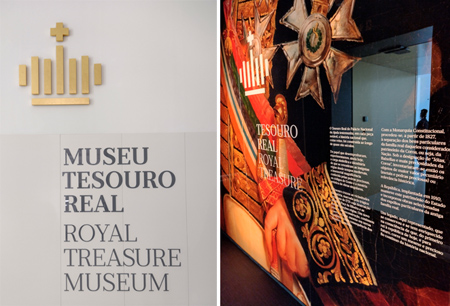
Love the cape! Decorations from other countries make up the first part of the exhibit. Low light ensures the objects on display truly shine:

Absolutely beautiful creations on display. Waiting for everyone to take photos can be a little tiresome… objects should be more scattered around the room for ease of viewing instead of presented in a linear fashion. Loved the ceremonial swords & star crown + necklace, but for me the most unexpected were the jewels worn for mourning. Of course. Even at a funeral service you are still royalty 😉

Larger-than-life portraits bring the royals to life:

The last floors highlight silver table service. I was less interested in that since there are so many other places in Lisbon that have good examples, like the Gulbenkian or the Museu de Arte Antiga. While I can’t say the Tesouro Real is a must-see for everyone, perhaps more people will visit the adjacent palace as a result being in the same building. Let me know what you think of it!